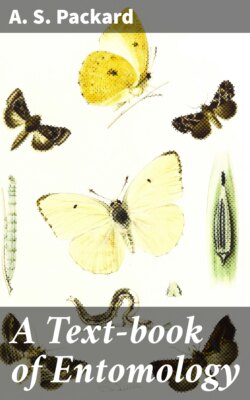Читать книгу A Text-book of Entomology - A. S. Packard - Страница 19
На сайте Литреса книга снята с продажи.
a. The head
ОглавлениеFig. 24.—Presumed larva of Nemoptera (Necrophilus arenarius), Pyramids of Egypt.—After Roux, from Sharp.
While the head is originally composed of probably not less than six segments, these are in the adult insect fused together into a capsule or hard chitinous box, the epicranium, with no distinct traces of the primitive segments. The head contains the brain and accessory ganglia, the mouth or buccal cavity, also the air-sacs in many winged forms, and gives support to the external organs of sense, the antennæ, and to the buccal appendages, the larger part of the interior being filled with the muscles moving these structures. The solid walls of the head serve as a lever or support for the attachment of these muscles, especially those of the mandibles. Thus there is a correlation between the large size of the mandibles of the soldier white ants and ants, the head being correspondingly large to accommodate the great mandibular muscles. The other extreme is seen in the larva of Necrophilus (Fig. 24), with its long slender neck and diminutive head.
The clypeus.—This is that part of the head situated in front of the epicranium, and anterior to the eyes, forming the roof of the posterior part of the mouth, and is, as embryology shows, probably a tergal sclerite. It varies greatly in shape and size in the different orders of insects. It is often divided into two parts, the clypeus posterior and clypeus anterior, or which may be designated as the post- and ante-clypeus (Figs. 29, B).
The labrum.—The “upper lip” or labrum is an unpaired flap-like piece hinged to the front edge of the clypeus, and may be seen to move up and down when the insect moves its mandibles. It forms the roof of the anterior part of the mouth (Figs. 69, 74), and its inner side is lined with a soft membrane, usually provided with hairs and sense-papillæ or cups, forming the epipharynx.
The labrum is more or less deeply bilobed, especially in caterpillars and in adult Staphylinidæ, and has been thought by some writers (Kowalevsky, Carrière, and also Chatin) to represent a pair of appendages, but Heymons (1895) refutes this view, stating as his reason that the labrum arises between the two halves of the nervous system (protocerebrum), while all the true appendages arise on each side of the nervous system. (See also Fig. 34.)
